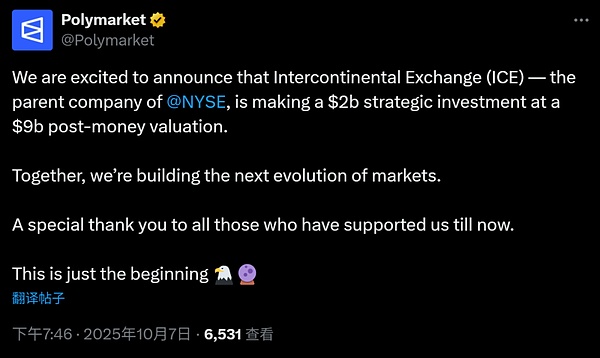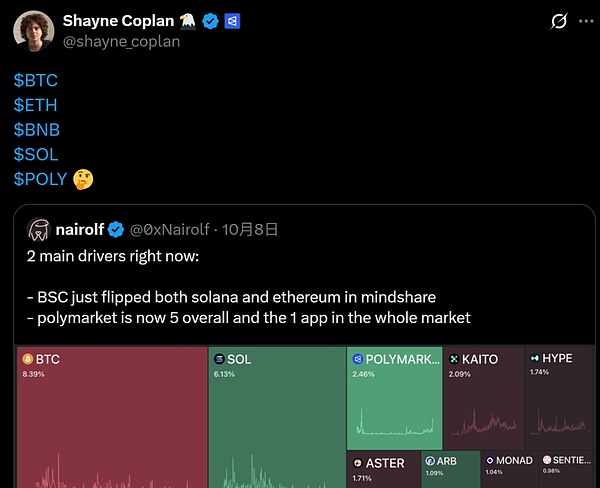When was the last time you heard about a $1 billion level financing in Web3?
On October 7, 2025, the prediction market Polymarket announced that the Intercontinental Exchange (ICE), the parent company of the New York Stock Exchange, would make a strategic investment of $2 billion, with a post-investment valuation of up to $9 billion. This is not only one of the highest amounts of financing received by projects in the Web3 space in recent years but also brings the potential and popularity of prediction markets to the forefront.
Interestingly, whether it’s decentralized players like Hyperliquid entering the new arena or compliant latecomers like Kalshi accelerating their catch-up, this competition is visibly intensifying.
Behind this, it’s not just about who will dominate the future of prediction markets, but also about how to financialize all uncertainties in the real world.

From Polymarket to Kalshi, Blossoming in Multiple Areas
Decentralized prediction markets have always been one of the important practical tracks in the early applications of blockchain. For instance, I frequently saw examples of early players like Augur in many popular science books years ago—whether it’s elections, weather, inflation, sports, or IPOs, users can directly trade "yes/no" contracts in a decentralized manner.
However, in reality, although the concept was proposed early on, it wasn’t until the emergence of Polymarket that this concept truly broke out of its confines, largely thanks to the boost from the 2024 U.S. presidential election:
Against the backdrop of traditional polls generally leaning towards one side, Polymarket ultimately proved that this decentralized prediction market, which uses "real money" to vote, has extremely high reference value for observing market trends with its precise predictions and verifiable price signals that surpassed polls.
This has led to Polymarket frequently becoming a reference source for probability cited by mainstream media in various events over the past six months. However, the prediction market has been struggling under the shackles of compliance. For example, in 2022, Polymarket was fined $1.4 million by the U.S. Commodity Futures Trading Commission (CFTC) for operating an unregistered derivatives market and was prohibited from providing services to U.S. users.
In the past two years, Kalshi, which was established even earlier than Polymarket, has emerged as a strong competitor, choosing a path focused on compliance—becoming the first prediction market platform regulated by the CFTC. In October 2024, a federal court also ruled that it was allowed to launch the first regulated election market in the U.S., further solidifying Kalshi's regulatory status.

Source: polymarketanalytics
As of October 10, 2025, comparing the data from Polymarket and Kalshi, aside from the total trading volume where Polymarket significantly outperformed with $1.3 billion vs. $410 million, Polymarket has fallen behind Kalshi in terms of the number of markets (10,200 vs. 43,500) and open contract volume ($170 million vs. $240 million).
Notably, in order to return to the U.S. market, Polymarket has also adopted a compliance integration strategy this year: as early as July, it acquired the CFTC-licensed trading platform QCX LLC for $112 million and has begun self-certifying event contracts, including sports events and election markets.
This is likely part of a combined strategy with the recent $2 billion massive financing, and Polymarket CEO Shayne Coplan also tweeted on October 9 with the POLY symbol, which could become a key variable in the competition between the two giants.

From Prediction Markets to a Larger Financial Ecosystem
Many may wonder why ICE, the parent company of the New York Stock Exchange, would place a massive $2 billion bet on Polymarket?
This requires stepping outside of Web3 and understanding prediction markets from a larger financial ecosystem perspective.
First, ICE has been actively laying out in the crypto space, including over the years establishing crypto financial products through its parent company and various affiliated entities, covering Bitcoin spot, futures contracts, and the well-known crypto trading platform Bakkt.
Secondly, prediction markets are essentially a subset of "trading platforms," or another form of presentation. For example, Polymarket has many price prediction bets for mainstream crypto assets like BTC and ETH at different time points, such as the end of October or the end of the year.
Theoretically, if the time nodes for predictions are infinitely subdivided—from the end of the year to the end of today, then to one minute later, one second later—this essentially becomes real-time "betting" (buying and selling behavior) on the trading platform. What ICE values may be precisely this ability to financialize all uncertainties, which can expand the boundaries of existing futures, options, and other derivatives markets.
Therefore, platforms like Polymarket, which have a large user base and trading volume, can serve as a key entry point for ICE Group's future structured financial products, institutional hedging tools, and information pricing services. In other words, ICE is not focusing on a single application but is betting on the potential of prediction markets to "derivatize everything" uncertain.
For this reason, in addition to the competition between Polymarket and Kalshi, which resembles a specialized path for event markets, decentralized players like Hyperliquid are also exploring a hybrid path of inserting prediction modules at the entry of high-performance contract platforms. Each path has its advantages and disadvantages, but they may complement or compete with each other in the future.
New Variables from Decentralized Players like Hyperliquid
For example, Hyperliquid's HIP-3 proposal introduces a permissionless, developer-deployed perpetual contract market on its core infrastructure. Previously, only the core team could launch trading pairs, but now any user who stakes 1 million HYPE can directly deploy their market on-chain.
In short, HIP-3 allows for the creation and launch of any asset's derivatives market on Hyperliquid without permission, completely breaking the limitations of past Perp DEXs that could only trade mainstream cryptocurrencies.
This not only means an open contract deployment mechanism but also lays the technical foundation for subsequent prediction market modules. In the future, users on Hyperliquid may be able to directly trade such markets:
- "Will the Federal Reserve lower interest rates at the next meeting?"
- "Will BTC break $70,000 this week?"
- "Will Arbitrum's TVL exceed Base by the end of the month?"
In this architecture, prediction markets are no longer an independent track but become a sub-module within the on-chain high-performance derivatives system. Since it reuses Hyperliquid's matching depth, clearing system, and order book logic, it naturally possesses higher trading efficiency and capital utilization.
In contrast, Polymarket's model leans more towards "event trading," while Hyperliquid's model leans more towards "price trading"—one starting from information, the other from structure, yet both pointing to the same ultimate goal: to have the market price future probabilities in real-time.
Final Thoughts
Overall, with the involvement of heavyweight decentralized players like Hyperliquid and the $2 billion investment from ICE as key nodes, prediction markets are no longer just a small tool for everyone to "bet" or "predict the future," but have become a front line for institutions, analysts, and even central banks to observe market sentiment.
This also means that it is no longer just a paradise for speculators but is rapidly transforming into a high-efficiency, high-liquidity financial derivatives market, becoming an indispensable financial primitive in DeFi infrastructure.
免责声明:本文章仅代表作者个人观点,不代表本平台的立场和观点。本文章仅供信息分享,不构成对任何人的任何投资建议。用户与作者之间的任何争议,与本平台无关。如网页中刊载的文章或图片涉及侵权,请提供相关的权利证明和身份证明发送邮件到support@aicoin.com,本平台相关工作人员将会进行核查。




